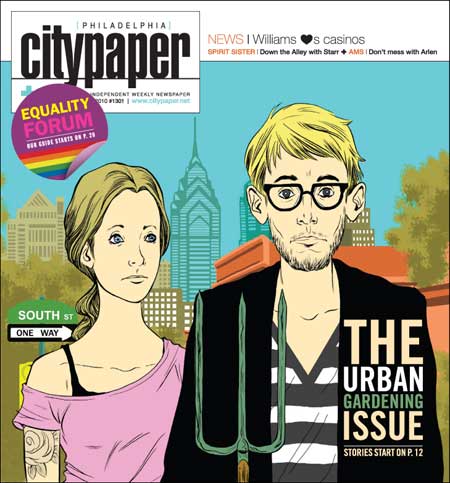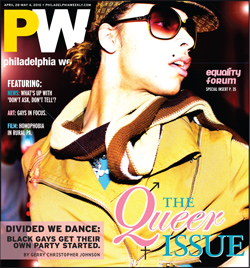 BY DAVE ALLEN Like time, news waits for no man. Keeping up with the funny papers has always been an all-day job, even in the pre-Internets era. These days, however, it’s a two-man job. That’s right, these days you need someone to do your reading for you, or risk falling hopelessly behind and, as a result, increasing your chances of dying lonely and somewhat bitter. That’s why every week PAPERBOY does your alt-weekly reading for you. We pore over those time-consuming cover stories and give you the takeaway, suss out the cover art, warn you off the ink-wasters and steer you towards the gooey center. Why? Because we love you!
BY DAVE ALLEN Like time, news waits for no man. Keeping up with the funny papers has always been an all-day job, even in the pre-Internets era. These days, however, it’s a two-man job. That’s right, these days you need someone to do your reading for you, or risk falling hopelessly behind and, as a result, increasing your chances of dying lonely and somewhat bitter. That’s why every week PAPERBOY does your alt-weekly reading for you. We pore over those time-consuming cover stories and give you the takeaway, suss out the cover art, warn you off the ink-wasters and steer you towards the gooey center. Why? Because we love you!
ON THE COVER
CP: The Urban Gardening Issue — doesn’t quite have the ring of the Music Issue or the Book Quarterly. It really sounds like the ultimate in niche publications. But the way government funding and hope for the future a la Nate Popkin’s “The Possible City” are tied up with this pastime-turned-passion, there seems to be more riding on urban agriculture than just how this year’s heirloom tomatoes will turn out. Isaiah Thompson digs into what we talk about when we talk about gardening.
There’s nothing radical about the idea of raising edible crops in the city: It’s been done for ages. And Philadelphia, it cannot be denied, has plenty of  land — including thousands of vacant lots.
land — including thousands of vacant lots.
What is a little more dubious is the sheer distance between what urban agriculture’s most idealistic proponents want it to mean to Philadelphia — a self-sufficient means of food production for the poor, a source of jobs, a cure for the ills of urban obesity and malnutrition —and its reality on the ground so far.
Whether that distance can be breached may be put to the test soon. In recent years, urban agriculture has had the luxury of defining itself in opposition: to a culture of cheap, pesticide-dependent produce; to a society increasingly isolated from and ignorant of the origin of its food; and to a city which has sometimes seen vegetable gardens on vacant lots as impeding development —rather than vice versa.
But about a year ago, something surprising happened: The city itself began to get all … urban aggy, with various city agencies coming up with proposals to sponsor new inner-city farms. Urban agriculture, all of a sudden, is in. The problem, quickly becoming apparent, is that no one quite agrees on what, exactly, it’s supposed to be.
In addition to shout-outs to the most successful spots — word up, Greensgrow — there’s a seam of agribusiness running through the piece, which may be just the ticket to get the city to take urban farming seriously. Elsewhere, Brendan Skwire injects backyard gardening with just a hint of bad-ass, and Thompson — dude’s a machine — pens an oddly touching tribute to raising worms and producing compost. Overall, I can dig it.
PW: This year’s Queer Issue already has a leg up on last year’s: no misleading pregnant dude on the cover. It’s digging into some serious issues as well, starting with a cover story that delves deep into the history of de facto segregation in the city’s gay nightlife scene. Newly minted columnist Gerry C. Johnson flexes some journalistic muscle here.
The segregation of gay nightlife has a legacy that dates back to at least post-War World II Center City, a playground ever bustling with underground  homosexual activity, and unadulterated racism. In City of Sisterly and Brotherly Loves: Lesbian and Gay Philadelphia, 1945-1972, a book of oral history collected by Marc Stein, local gays recount racial tensions during that era with equal clarity. “If you went to bed with a black person, they said you were a dinge queen,” recalls Ray Daniels, a white interview subject.
homosexual activity, and unadulterated racism. In City of Sisterly and Brotherly Loves: Lesbian and Gay Philadelphia, 1945-1972, a book of oral history collected by Marc Stein, local gays recount racial tensions during that era with equal clarity. “If you went to bed with a black person, they said you were a dinge queen,” recalls Ray Daniels, a white interview subject.
Facing such racist attitudes, black gays quickly found out where they weren’t wanted—south of Market Street and north of Lombard. “We might like to think that the queer world would do better than the straight world on matters of internal divisions, conflicts, and hostility,” says Stein, a sexuality studies scholar. “But there’s no reason to think that’s the case. American society was racist. The gay world reflected that and contributed to that,” he says, adding that class also played a part.
While some black gays managed to mix in with their white counterparts, others were forced to create their own social gatherings, aka house parties. Eventually, they formed their own nightlife scene in designated areas of Center City or in the black neighborhoods of North and West Philadelphia. Early establishments included Nick’s on South Street. Unified by race, black gays and lesbians often partied together.
By the 1980s, blacks had established a viable underground scene of their own. Gary Hines, host of The Catacombs, a show on Germantown Radio dedicated to house music, remembers a vibrant gay club scene where patrons flocked to hear music that was black like them: “Only You” by Teddy Pendergrass, “Respect” by Adeva, “Hot Shot” by Karen Young. Partygoers were catered to by live DJs who played sweltering underground house one minute and the “Sound of Philadelphia”—usually slowed down or mashed up—the next. “The DJs would do some amazing things on turntables,” Hines says.
Johnson delivers with a knowledge of the scene and of its major players and promoters, revealing untold stories and whole worlds that exist in the wee small hours. I’m just a heteronormative white guy — to me, Shampoo is a Warren Beatty movie — but the collective sense of fun-seeking and secrecy had me hooked.
INSIDE THE BOOK
CP: The season of the Creepy Voiceover Guy. Heir to Fast Eddie? Philly’s man in the governor’s race. We wanted a hit: New LCD Soundsystem. Drinking in an alley: More than Mad Dog 20/20.
PW: “Red said, blue said,” for the 87 millionth time. Asking the tough questions on Don’t Ask Don’t Tell. Pennsyltucky: Still backward. Seventh-inning smorgasboard.
WINNER: I’ma give it up for PW’s cover story, with its blend of insider knowledge and compelling storytelling. Deep down, we are all the sum of the pleasures we seek. For some, it’s a quiet bar and craft beer; for others, it’s clubs, and Gerry Johnson really brought the latter to life.
